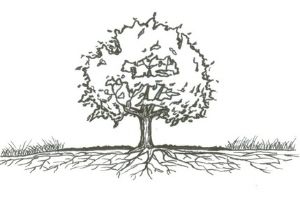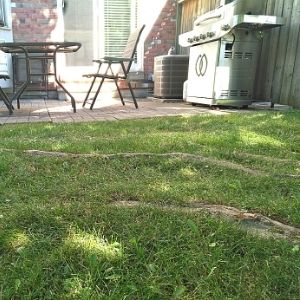Roots Spread Out, Not Down

The classic portrait of a tree is one where its roots match its canopy. In other words, one where the above ground portion of a tree (the canopy) mirrors the belowground portion (the root system). Although it is a popular image, it is in fact a misconception. Roots do not grow as deep as a tree is tall. The vast majority of tree roots stay within the top 50 cm of soil and extend outward two to three times the width of the canopy. This widespread, shallow root system allows a tree to anchor itself and access essential resources, like water and oxygen, which are harder to come by at deeper levels in the soil.
With this in mind, selecting an ideal planting location that allows a tree to grow unobstructed above and belowground will reduce problems down the road. This means ensuring that a tree is planted with enough soft ground space like soil or grass, as well as planted away from areas that could result in conflict, such as existing structures (like buildings or decks), hard surfaces and property lines or fences. In addition, it is vital to request underground utility locates before planting to ensure your safety and to confirm a tree will not be planted on top of a buried cable or line.
Roots Are Searching for Resources, Not Foundations or Pipes

Roots are responsible for absorbing life-supporting resources, like oxygen, nutrients and water. Because of this, roots tend to grow towards these resources and always look for the path of least resistance while doing so. When roots come up against a solid object, such as a concrete foundation or a pipe, they will grow alongside it since they are not able to penetrate it. However, if a concrete foundation or a pipe is already damaged, roots may enter existing cracks, as there is often available moisture to exploit in these areas. Remember, tree roots do not cause cracks in built infrastructure, they only take advantage of the water or oxygen they find within them.
To avoid indirect damage, it is important to make sure a tree has access to the resources it needs to grow. Planting a tree in a location with its appropriate growing conditions ensure that its resource needs are being met. Each tree species has its own set of preferred soil, sunlight and moisture conditions. Selecting a tree with conditions that match those of the planting space is essential for the long-term growth and health of a tree. Planting a tree in unsuitable conditions can lead to nutrient deficiencies, stress, poor health and even death.
Another important must of tree care is regular watering. This ensures a tree’s moisture needs are being met. Newly planted trees should be watered twice per week for the first two years after planting, using approximately six gallons of water each time. This is the equivalent of using three full watering cans, or a hose with no nozzle on a very slow trickle for approximately 15 minutes. For more mature trees, water as needed from spring through fall. Check the soil under the canopy of the tree by sticking your finger down into it. If it’s dry and hard, it’s time to water! This is particularly important during the dry summer months.
When it comes to roots, prevention is the best solution. Keep your foundation and pipes in a state of good repair. And, always plant trees away from potential risk areas in proper growing conditions. Then, provide adequate watering so that trees have what they need to thrive.
Need help planting the right tree in the right place? The LEAF subsidized Backyard Tree Planting Program includes a consultation with a certified arborist who assesses your yard, recommends planting locations and the native tree species that are best suited for your property’s unique soil, sunlight and spacing conditions. Apply online today to get started.
Want to add greenery to your property but do not have enough unobstructed space for a tree? Shrubs are an excellent alternative for smaller properties!
Jess Wilkin is the Residential Planting Programs Operations Coordinator. She holds a Master’s of Forest Conservation from the University of Toronto.
LEAF offers a subsidized Backyard Tree Planting Program for private property. The program is supported by the City of Toronto, the Regional Municipality of York, the City of Markham, the Town of Newmarket, the Regional Municipality of Durham, the Town of Ajax, the City of Oshawa, the City of Pickering, the Township of Scugog, the Town of Whitby, Ontario Power Generation, Ontario Trillium Foundation and GrandTrees/Canadian Trees For Life.
